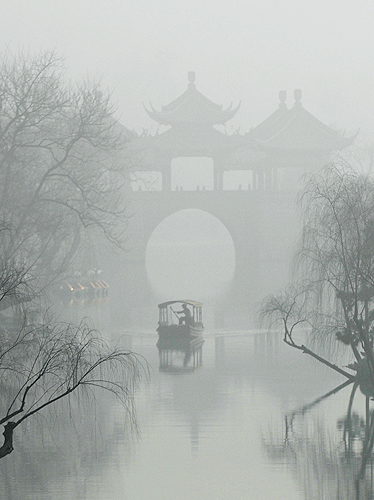|
 |
|
DREAMY CITY: The Five Pavilion Bridge of the renowned scenic spot Slender West Lake during a foggy day in Yangzhou, Jiangsu Province (CFP) |
My first taste of China outside Beijing began with a swing through eastern Jiangsu Province's Yangzhou and Zhenjiang cities, along the fabled Yangtze River. The area northwest of Shanghai does not find itself featured prominently in many guidebooks. But one can spend a considerable amount of time in either destination without seeing a foreigner.
At once unique and spellbinding, these two cities offer delightful cuisine and friendly people who are eager to help immerse visitors in their culture, for which they have distinctly enthusiastic pride.
Our journey began in Yangzhou. This metropolis of 1.1 million people offers an illustrious history dating back 2,500 years from the time of the Sui Dynasty (581-618). The legendary Marco Polo once governed the region under Mongol Emperor Kublai Khan between 1282 and 1287.
Not surprisingly, Yangzhou's history has left its indelible footprint on its modern layout and architecture. During the Tang Dynasty (618-907), for example, Yangzhou was also home to a significant number of ethnic Persians and Arabs.
Nonetheless, many of the older parts of town—particularly between the commercial center and the Grand Canal that bisects the city—still faintly, yet distinctly, echo the markets and bazaars for which so much of the near and Middle East are world-famous.
Also of interest to the outsider are the other quiet canals that provide a sanctuary from the bustle of the city center nearby. The Grand Canal section we walked along at one point offered a delightful respite from the chaotic scene nearby.
We then strolled amid the neighborhoods behind the canals, as the scents of sesame seed cakes and deep-fried donuts wafted through the air. While I experienced something distinctly Asian, and most certainly Chinese, we also felt something universal.
Maybe it was the peace. It came with the humble and quiet homes all around—the content braying of animals, or the gentle smoke of food roasting on grills and, of course, the people inside and out. Some watched television, or played cards; others contentedly sat before their fans, trying to stay cool amid the heat.
We could have been anywhere: a town in rural Italy, or even a small quaint, seaside city in the Caribbean, Latin America or North Africa.
Farther south we were greeted by Zhenjiang, a city of 625,000 that has an edgy charm not unlike that of inland cities of similar size in South America—Belo Horizonte, Brazil or Valencia, in the central Venezuelan highlands.
Of course, it is also very Chinese, too—its grittiness is more conspicuous than even much of Beijing. Its bustling, open-air markets and the rickshaw-like tricycles plying the streets offer the outsider just a hint of Mumbai. It may be about as eclectic a place as one can find along the Yangtze.
My host there and his family brought me to a quiet park astride the Yangtze on our first night in town. On the opposite side was a sprawling marsh before miles of open wetlands, with Beigu Hill looming in the background.
Moving on, we saw charred paper and cardboard on the cement steps beside us. They were evidence, my host said, of the previous evening's celebration of "Ghost Day."
The next day, after a hearty noodle breakfast, we made an early morning ascent up Jiaoshan Hill to the fabled Dinghui Temple. It wasn't an easy hike, but the destination was well worth the trip.
The panoramic views afforded by the rebuilt temple offered as clear an understanding as any guidebook as to why the structure served as a critical garrison against British forces during the First Opium War (1840-42).
In fact, Zhenjiang's history itself reveals how the city had been a successful rampart against hostile invaders throughout history. After 581, when it was first conquered by the Sui Dynasty, the city became a fort that guarded the entrance to the Yangtze River, thus the name Zhenjiang, which literally means "Garrison River."
The final but most interesting stop on my journey consisted of a visit to a Qing Dynasty (1644-1911) port further down the Yangtze. Preserved for tourists, this miniature community holds buildings with tiny and almost mathematically structured windows.
While they are truly a testament to architecture in this part of North Asia, many of these two-story structures have something of a slight overhang reminiscent of New Orleans or some other city of Indo-European heritage.
Zhenjiang and Yangzhou make great side trips for tourists to explore distinctive architecture, cultural heritage and food when they are in nearby Shanghai. The intrepid visitor won't regret it. | 